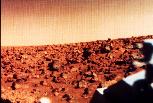Viking Image List
Viking I Landing site - Chyrse Planitia

An image of Mars from the Viking I lander. (Courtesy NASA/JPL)

Soil sampler with completed trench, from the Viking I lander. (Courtesy NASA/JPL)

A panorama of the Martian landscape from the Viking lander. This region is called Chryse Planitia. (Courtesy NASA/JPL)

An image of Mars from the Viking lander. (Courtesy NASA/JPL)

A panorama of the Martian landscape from the Viking lander, complete with data screen. (Courtesy NASA/JPL)

Sand dunes in the Chryse Planitia Basin, from the Viking I lander. (Courtesy NASA/JPL)

Winddrifts at the Viking I landing site. Drifts such as these were also studied by the Mars Pathfinder mission. (Courtesy NASA/JPL)

Viking I sunset. (Courtesy NASA/JPL)
Viking II Landing site - Utopia Planitia

An image of Mars from the Viking lander. (Courtesy NASA/JPL)

An image of the Viking II lander. The symbol of the American bicentennial celebration from 1976 can be seen on the lander. (Courtesy NASA/JPL)

An image of Mars from the Viking II lander. (Courtesy NASA/JPL)

An image of Mars from the Viking II lander. (Courtesy NASA/JPL)
Viking Orbiter results

An image of Mangala Valles from the Viking orbiter. Viewing of this image in high resolution is recommended. (Courtesy NASA/JPL)

Ice cliffs at the North polar region. Viewing of this image in high resolution is recommended. (Courtesy NASA/JPL)

Valles Marineris from the Viking orbiter. Viewing of this image in high resolution is recommended. (Courtesy NASA/JPL)

This is a false color image of the Valles Marineris showing possibility of erosion. (Courtesy of NASA)
(243K GIF)

This is a false color image of the Valles Marineris. (Courtesy of NASA)
(213K GIF)

This is an image of the South Candor Chasma. Viewing of this image in high resolution is recommended. (Courtesy of NASA/JPL)
(146K JPG)

This is a false color image of the caldera collapse pit at the summit of one of the large volcanos on the Tharsis plateau. Viewing of this image in high resolution is recommended. (Courtesy of NASA)
(197K GIF)
Go back to Mars, Pluto, Mercury, Saturn, Neptune, Venus, Moon, Jupiter, Asteroids, Comets, Sun, Missions, Uranus, Astrophysical Objects, Mariner Images, Mars Pathfinder Images, Mars Global Surveyor Images














